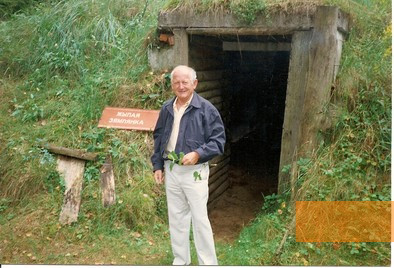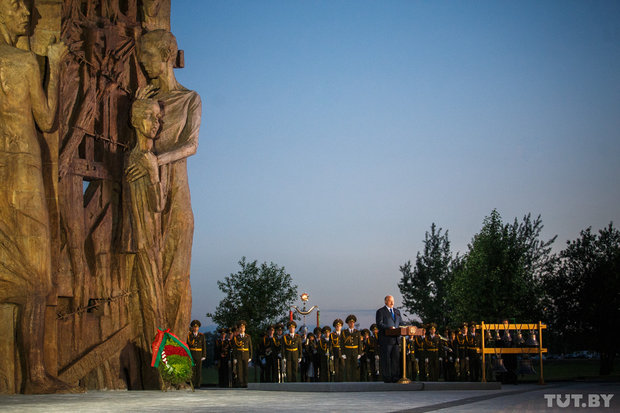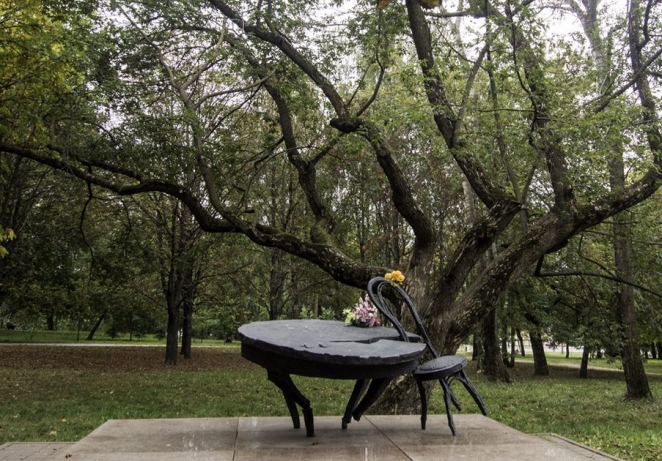What do Belarusians remember about the Holocaust?
31 May 2018, 20:08
In the Polish town Oświęcim, on the eve of the 73rd anniversary of the liberation of Auschwitz, the district court passed sentence. The case concerned a nude performance last spring near the memorial to the Nazi death camp. Twelve people in their 20s, among them five Belarusian citizens, had slaughtered a lamb, stripped and chained themselves to the gates of the former camp where more than one million innocent people perished during World War 2.
Although intended as a pacifist protest, the performance made little sense to spectators. The unfortunate choice of location cancelled out the anti-war message, bringing on the protesters charges of desecration.
Though of a different nature, a distinct lack of reflection over the largest tragedy of the 20th century marks the mainstream perceptions of the Holocaust in contemporary Belarus. Here, the Holocaust serves as a background for narratives of wartime heroism. The commemoration often depends on individual initiatives and support from abroad.
The lost world of Jewish Belarus
On the eve of the Nazi invasion of the Soviet Union in June 1941, the Jewish population was the third largest ethnic group on Belarusian territories, often making up about 50 per cent of the urban population. Ancestors of Isaac Asimov, Kirk Douglas, Shimon Peres, Menachem Begin and many others were born on Belarusian soil.
Yet most Belarusian Jews perished in the Holocaust. Historians estimate that over 800,000 Jewish people died in Belarus during WWII, among them about 90,000 European Jews deported from Austria, Germany, the Netherlands, Hungary, France and Poland. In contrast, today only about 30,000 Jews call Belarus their home.
One of 240 ghettoes on Belarusian territory, the Minsk ghetto was also one of the largest in Eastern Europe. American historian Barbara Epstein says that the strong ties between the ghetto, the underground, and partisan movement became a unique feature of Minsk during wartime. Connections to the partisans helped many Belarusian Jews to survive.
The prisoners of the Navahrudak ghetto succeeded in digging a 220-metre long tunnel through which 250 people fled into the forest. Jared Kushner’s ancestors, who later emigrated to the United States, numbered among the survivors of that daring escape. Now, the Kushner family provides financial support for the tunnel memorial in Navahrudak, currently under construction.
Since 2007, Navahrudak also houses a small Museum of the Jewish Resistance. Financial support for the museum comes from Jack Kagan; a former prisoner in the ghetto and later a partisan in the famous Bielski Brothers’ unit.
The challenges of Holocaust education
Many Belarusians do not know this history since Belarusian school textbooks still lack comprehensive coverage of the Holocaust. The current political regime eagerly uses the themes of the Great Patriotic War and the partisan movement to construct a specific state ideology, which is based on positive references to wartime heroism.
In this context, independent initiatives expose deficiencies of history education in Belarus. The case of a history teacher from Asipovičy, Neanila Cyhanok, provides an illustration. In an attempt to expand Holocaust history’s place in the school curriculum, she spent the last ten years of her life collecting oral history materials on Jews and their saviours. Yet Cyhanok also admitted that she encountered antisemitic stereotypes in reaction to her involvement with the memory of the Holocaust and extra-curricular activities.
Holocaust memorial sites often appear through individual initiatives or with the support of Jews from abroad. Last year, businessman Siarhei Koval from Navahrudak supported the creation of a monument to the children who perished during the Holocaust. The monument depicts a Jewish girl from Navahrudak, Mihle Sasnouskaja, who managed to escape from the ghetto, only for the Nazis to shoot her later.
Since 2003, the Simon Mark Lazarus Foundation in cooperation with Belarusian Jewish organisations has erected 110 memorials in an effort to commemorate over 500 massacre sites across the country.

Belarusian society: coming to terms with the Holocaust
The focus on the partisan struggle and developing a cult of the last war leaves little space for the Holocaust in official memory politics. For instance, the rebuilt Museum of the Great Patriotic War in Minsk hardly focuses on the extent of Jewish suffering during WWII, referring to victims as merely civilians in its main exhibits.
The museum’s description of artefacts from the Maly Trascianec death camp states that it was the 4th largest Nazi death camp, after Auschwitz, Majdanek, and Treblinka. Yet the museum visitors only learn that ‘in three years, more than 200,000 citizens from the Soviet Union and occupied countries of Western Europe were killed there.’

Nevertheless, in recent years the official Holocaust memory politics showed signs of positive changes. In 2015, President Lukashenka unveiled a new memorial on the territories of the former death camp Maly Trascianec. Until recently this remained a forgotten site in the vicinity of the Belarusian capital. Historians note that Stalinist executions took place at Trascianec from the late 1930s through to the summer of 1941, which might explain its oblivion.
From March 2017, the joint German-Belarusian exhibition ‘Death Camp Trascianec: History and Memory’ tours both Belarus and Germany, telling the stories of Maly Trascianec’s victims. In January 2018, it opened in Mir Castle – a famous tourist landmark that used to be a Jewish ghetto during the WWII.
So far, no sociological data exists to evaluate either public knowledge or perceptions of the Holocaust within Belarusian society. The brutality of the war and the extermination of the entire ethnic groups, such as the Jews or Roma, still awaits a proper commemoration. In this respect, a comprehensive discussion of the Holocaust as part of the school curriculum might pave the way towards a better understanding of the past.


